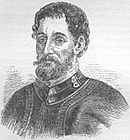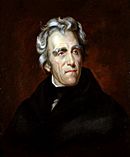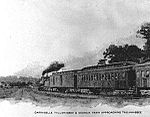History of Leon County, Florida facts for kids
The history of Leon County, Florida, much like the history of Tallahassee, goes back a very long time to when people first settled the Americas. In the 1500s, Europeans began to settle this area, making it part of Spanish Florida. In 1819, the Adams–Onís Treaty gave Spanish Florida, including what is now Leon County, to the United States. Leon County was named after the Spanish explorer Juan Ponce de León. It officially became a U.S. county in 1824. After the Americans took over, the county grew quickly. Many cotton farms started to appear, which made Leon County's population grow a lot.
Contents
Ancient Times
Leon County, Florida, like most of North America, was home to many ancient animals that are now extinct. Some lived as far back as 33 million years ago. There are no dinosaur fossils in Florida. Before the Miocene period, Florida was mostly underwater. It was like a big, flat platform made of carbonate rock. When this area filled with dirt and sand, the Florida Platform became dry land. This allowed plants and animals to live there. Early dogs, bear-dogs, large cats, and other meat-eating animals moved to Florida. They followed their prey, which included ancient ruminants and deer-like mammals.
- See: Leon County, Florida paleontological sites.
Early People in Florida
The story of humans living in Florida is divided into different time periods. These are the Paleoindian, Archaic, Woodland, Mississippian, and Protohistoric periods. Most of these periods are also split into Early, Middle, and Late parts.
What is now Leon County was first lived in by Paleo-Indians or people of the Clovis culture about 12,000 years ago. This was during the Upper Paleolithic period. These early people were hunter-gatherers. They lived near water sources in Leon County. Many large animals also shared these water sources. These animals included ancient bison, Mastodons, Ice Age camels, giant ground sloths, saber-toothed tigers, Columbian mammoths, ancient horses, short-faced bears, and American lions.
Archaic Period Life
The Archaic cultures lived from about 10,000 to 2,500 BCE. The climate became more humid, and sea levels rose. The land and ecosystems started to look much like they do today. More people lived in the area, and they began to settle in smaller territories. People started using triangular-shaped spear points. It's thought they used spear throwers to hunt animals more easily. These changes led to people adapting to the specific resources in their local areas. In the Apalachee region, this time is also known as the Norwood culture.
Woodland Period Life
The Woodland period lasted from about 2,500 BCE to 900 CE. During this time, people started using pottery widely. Pottery became more complex in its shapes and decorations. People also began to use more agriculture. This meant that many nomadic tribes started living in permanent villages. However, farming really grew during the Mississippian period. People also began burying their dead in mounds with special items.
Deptford Culture
The Deptford culture was the first part of the Woodland tradition in Florida. These people mainly lived along the coast, but some lived inland. Their pottery was decorated with stamps. This pottery was made with clay or sand, not plant fibers.
Swift Creek Culture
The Swift Creek culture first appeared around 100 BCE. Villages were built in large numbers in the forests and river valleys. Their pottery was known for its complicated stamped designs. These sites are common in the Red Hills Region. Gardening was likely part of their way of life, but there isn't much proof of farming. They used more bone and stone tools than people in the Deptford period.
Weeden Island Culture
The Weeden Island culture lasted from about 400 to 1000 CE. It is thought to have grown from the Swift Creek culture in northwest Florida. Weeden Island sites have been found from Mobile Bay to south of Tampa Bay. These people often lived around lakes like Lake Miccosukee and Lake Iamonia. They started growing maize (corn). Their pottery included plain and complicated stamped designs.
Mississippian Culture
From 1100 to 1500 CE, the Mississippian culture was very active. The Lake Jackson Mounds site was a major center for this culture. It was part of the Leon-Jefferson culture, an advanced society of the Fort Walton culture. The Lake Jackson Mounds are now part of the Lake Jackson Mounds Archaeological State Park in Tallahassee. This site had a large village and a central gathering place. It was one of the most important ceremonial places in the southeastern United States. The rich red clay soils of the Red Hills Region allowed these people to grow many crops.
16th Century: Spanish and British Influence
Spanish Rule Begins
Pánfilo de Narváez and his group passed south of Leon County in 1528. In 1539, Hernando de Soto stayed for five months at the Apalachee Indian capital called Anhaica. He brought priests with him. The first Christmas in the New World was celebrated in the woods near where the capitol building is today. As more Spanish settlers arrived, they brought diseases and fighting. This caused the Apalachee tribe's population to shrink, and they moved west.
In 1647, the Apalachee revolted against the Spanish near a mission in present-day Leon County. After this revolt, Apalachee men were forced to work on projects in St. Augustine or on Spanish farms.
In 1656, a Spanish deputy governor and his group settled in an Apalachee town they called Mission San Luis de Apalachee. This town was in west Tallahassee. It had more than 1,400 people. The Spanish built one of their Franciscan missions there. They lived off the generosity of the Apalachee people. At the same time, they tried to convert the Apalachee to the Catholic faith.
British Rule and Raids
Starting in 1700, the English saw Florida and its Spanish missions as being too close to their own colonies. Raids began from South Carolina, led by Governor James Moore. Sometimes, Creek Indians helped him. They raided and destroyed the Spanish missions, including San Luis in 1704.
Tens of thousands of Apalachee Indians were taken away as slaves by Governor Moore. They were never seen again. The Apalachee had adopted Spanish culture so well that when San Luis was burned, it was hard to tell the Apalachee bodies from the Spanish ones. The English brought Yamassee Indian allies from South Carolina. But ten years later, the English drove them out. So, the Yamassee moved to St. Augustine and allied with the Spanish. By 1705, the raids were over. The Seminole Indians then developed their "fowl towns," named because they raised chickens.
18th Century: Spanish Return
Florida Returns to Spain
In 1795, what is now Leon County, along with the rest of Florida, went back under the rule of Spain. Over the years, settlers in Georgia attacked Indian towns in Florida. In return, Indians attacked settlers in Georgia. This led to a military campaign by the United States Army and Andrew Jackson in 1817-1818, known as the First Seminole War. In 1818, Jackson invaded the small village of Miccosukee in what is now northeastern Leon County.
19th Century: American Territory and Statehood
Florida Becomes a U.S. Territory
In 1821, Florida became a territory of the United States. Both St. Augustine and Pensacola wanted to be the capital city. Lawmakers had to travel between the two cities for their meetings, which was dangerous and took almost twenty days.
General Andrew Jackson was the military governor of the new territory. He chose two people to find a good new place for the state capital. One rode a horse from St. Augustine, and the other sailed by boat from Pensacola. They met at the port of St. Marks, Florida, about 20 miles (32 km) south of today's Tallahassee. They found a spot north of St. Marks. They said, "A more beautiful country can scarcely be imagined; it is high, rolling, and well watered, the richness of the soil renders it perfectly adapted to farming."
On March 30, 1822, the United States combined East Florida and part of West Florida into the Florida Territory. Leon County was created in 1824. It was originally part of Escambia and later Gadsden County. It was named after Juan Ponce de León, the Spanish explorer who was the first European to reach Florida.
Early Governors from Leon County
- Richard K. Call served as governor from 1836 to 1839 and again from 1841 to 1844. He owned land in Leon County as early as the 1820s. He started Orchard Pond Plantation and The Grove Plantation.
- John Branch served from 1844 to 1845. He moved to Leon County in the 1830s and bought land to start Live Oak Plantation.
- See also List of governors of Florida
Leon County Plantations
In the 1820s and 1830s, many northern planters came to Leon County. People like R.K. Call, John Branch, Francis W. Eppes, William Bailey, the Chaires brothers, the Bradford brothers, and George Taliaferro Ward started large cotton plantations in Leon County. This area, then called Middle Florida, had fewer people than East or West Florida. It was easier to build a plantation economy based on enslaved people here.
Second Seminole War and Railroad
The Second Seminole War (1835-1842) affected Leon County. For example, family members and enslaved people of Green A. Chaires were attacked at his plantation on Lake Lafayette.
In 1837, the Tallahassee Railroad was finished. It connected Tallahassee to the port of St. Marks on the Gulf coast.
Forts in Leon County
During the Seminole Wars, five forts were built to protect settlers:
- Fort Braden (1839-1842) was on the Ochlockonee River.
- Fort Harriet (1840) was near the Sopchoppy River, 17 miles (27 km) northwest of St. Marks.
- Fort Macomb or Fort Number One M (1839-1842) was 10 miles (16 km) north of St. Marks.
- Fort Number Two (M) (1839) was on the St. Marks River south of Rose, Florida.
- Fort St. Augustine (1839) was 9 miles (14 km) northeast of Fort Macomb.
Early Statehood and Wealth
On March 3, 1845, Florida became the 27th state to join the United States. Leon County became the capital county of Florida.
From 1850 to 1865, Leon County was the richest county in Florida. It was a "cotton kingdom." It ranked 5th among all counties in Florida and Georgia for producing cotton. It also had the most people in Florida. The Florida Constitutional Convention of 1838 gave Leon County 6 electors, more than any other county.
1860s: Civil War and Reconstruction
Florida left the Union on January 10, 1861, and joined the Confederacy. Many men from Leon County went to fight in battles, even as far north as Gettysburg.
The only battle of the Civil War in Leon County happened on March 6, 1865. This was the Battle of Natural Bridge. A small Confederate force of about 1,000 men, including students from the West Florida Seminary, fought against U.S. Colored Infantry units. Leon County supported the war effort with three military camps: Camp Leon, Camp Lay, and Camp Mary Davis, all set up around 1861.
Many men from Leon County served in different military units. Officers from Leon County included George Taliaferro Ward, George Washington Scott, Patrick Houston, and Frederick L. Villepigue.
The Southern Homestead Act of 1866 opened up government lands in several states, including Florida, for homesteading. With help from the Freedmen's Bureau, formerly enslaved people could get land. Many came to Florida, especially from Georgia and the Carolinas, to get farmland in Leon County.
The 1880s and 1890s
William D. Bloxham, a Leon County resident and cotton plantation owner, served as Governor from 1881 to 1885 and again from 1897 to 1901.
The Carrabelle, Tallahassee and Georgia Railroad
The Carrabelle, Tallahassee and Georgia Railroad started service in the 1880s. It connected the Gulf coast to southern Georgia.
20th Century: Farming Changes
1900 through 1920: Dairy Farming Grows
Around 1900, dairy farming grew from a small side business to a large industry. Leon County became the top county for milk production by 1900. Butter was a main product, and skim milk was fed to hogs. By 1916, Jacksonville was getting milk for ice cream from Leon County. By 1918, about 1,000 gallons of milk left Leon County daily for processing plants in Jacksonville. The dairy industry became a $100,000 a year business. The Leon County Dairy Association was formed in 1918. The 1920 census showed Leon County had 7,885 dairy cows, producing 589,350 gallons of milk. Tallahassee's first milk plant opened by 1923, and there were 25 working dairies in Leon County.
Robert F. Bradford, Jr. joined the dairy business in 1911 with 100 Jersey cattle. His farm was one of the first in the county to have silos. Dairy farming stopped on this farm in 1935 when it was sold.
1940 through 1960: Beef Cattle Increase
The 1940s through 1960s saw more beef cattle being raised in Leon County. Some of this growth was due to the St. Joe Paper Company and some large game plantation owners. Some of Leon County's beef producers included Payne H. Midyette, Sr. and Payne H. Midyette, Jr. In 1939, Payne Sr. brought the first purebred Hereford cattle herd into the county.






